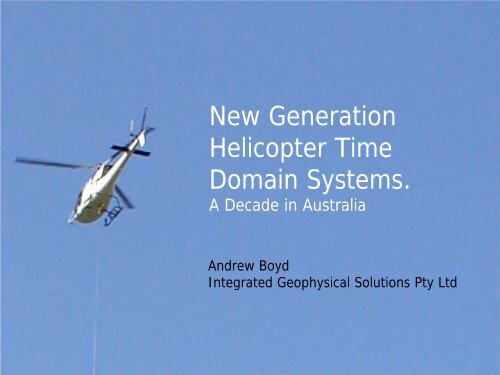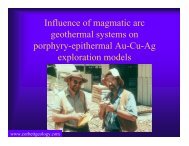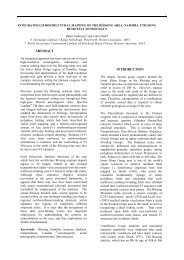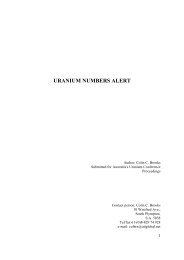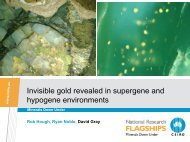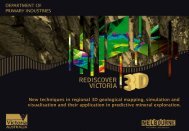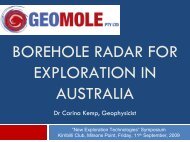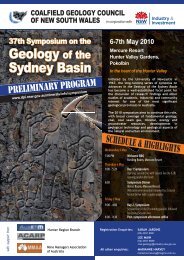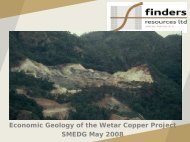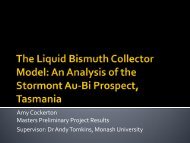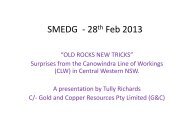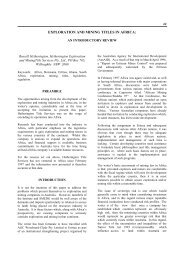Andrew Boyd New generation helicopter time domain EM systems
Andrew Boyd New generation helicopter time domain EM systems
Andrew Boyd New generation helicopter time domain EM systems
You also want an ePaper? Increase the reach of your titles
YUMPU automatically turns print PDFs into web optimized ePapers that Google loves.
<strong>New</strong> Generation<br />
Helicopter Time<br />
Domain Systems.<br />
A Decade in Australia<br />
<strong>Andrew</strong> <strong>Boyd</strong><br />
Integrated Geophysical Solutions Pty Ltd
Outline<br />
• Key design characteristics of a HTD<strong>EM</strong> system<br />
• A History of HTD<strong>EM</strong> in Australia and Systems in Use<br />
• Applications<br />
• Interpretation<br />
• Over the Rainbow<br />
www.igs.net.au
Numerous Flavours of Airborne <strong>EM</strong>.<br />
Platform and Waveform<br />
FD<br />
Frequency Domain<br />
Geol Survey Finland<br />
en.gtk.fi<br />
DIGH<strong>EM</strong><br />
www.fugroairborne.com<br />
TD<br />
Time Domain<br />
Geotem<br />
www.fugroairborne.com<br />
www.gpxsurveys.com.au<br />
www.igs.net.au
A<strong>EM</strong> Systems<br />
• We would like all three<br />
corners. Not possible from<br />
fixed wing A<strong>EM</strong> <strong>systems</strong><br />
• FD<strong>EM</strong> Systems don’t have<br />
large power<br />
• Helicopter TD<strong>EM</strong> <strong>systems</strong><br />
have developed to<br />
help fill the gap<br />
and try and fill in<br />
more of the<br />
triangle<br />
www.igs.net.au
Key factors to development<br />
• Design Objectives<br />
– Time Domain, broad bandwidth<br />
– Symmetric response<br />
– Low flying,<br />
• Closer to bedrock targets<br />
• high spatial resolution for mapping<br />
– Ease of installation, improved mobility &<br />
deployment<br />
www.igs.net.au
Broad Bandwidth<br />
Reading Time<br />
Reading Time<br />
• Time <strong>domain</strong> <strong>systems</strong> transmit<br />
multiple frequencies at once. The<br />
broader the frequencies the<br />
broader the range of geological<br />
scenarios that can be handled.<br />
This gives an immense advantage<br />
over frequency <strong>domain</strong> <strong>helicopter</strong><br />
<strong>systems</strong><br />
• A sharp termination of TD waveform<br />
generates high and broad frequency<br />
content.<br />
• High frequencies improve vertical<br />
resolution and mapping ability<br />
FD<strong>EM</strong><br />
www.igs.net.au<br />
• Power improves depth penetration but<br />
reduces ability to have a sharp<br />
termination. So often a trade off with
Symmetry<br />
• In-loop or Coincident loop Geometry.<br />
• No Asymmetry, no dependence on direction<br />
of flying<br />
Asymmetric Response,<br />
From Fixed wing<br />
Symmetric Response,<br />
From Helicopter system<br />
www.igs.net.au
Flying Height & Footprint<br />
• Foot print or Field of View of system is area energised<br />
(normally based on very early <strong>time</strong>) .<br />
• The higher you are,<br />
the broader you see<br />
• Foot print gets bigger with depth,<br />
so resolution goes down<br />
Vertical Foot Print<br />
Helicopter In loop Fixed Wing<br />
~95% of Field ~90% of Field<br />
www.igs.net.au
Flying Height– Controls benefit of line<br />
spacing<br />
200 m 400 m 600 m<br />
www.igs.net.au<br />
SkyT<strong>EM</strong> data courtesy Geoforce
Ease of Installation<br />
• Allows aircraft of convenience,<br />
not permanently installed,<br />
Just hang it on<br />
• Can drive down survey cost....<br />
.... but not necessarily for ever<br />
Can be cheaper<br />
mob.<br />
Cost/km<br />
www.igs.net.au<br />
Shorter<br />
Line Lengths<br />
Size of job<br />
Heli<br />
Fixed Wing
Key factors to development<br />
Technology Drivers<br />
– Composite materials<br />
– Electronics, smaller form and power<br />
Needs to be light and fit on a hook<br />
– Trade offs in for intended use<br />
•Weight,<br />
• Power and Bandwidth<br />
• Flying speed (aka cost)<br />
Lets look at <strong>systems</strong> having operated in Australia and see<br />
how these compromises have manifested themselves...<br />
www.igs.net.au
10 years of<br />
HTD<strong>EM</strong> in Aus<br />
• Circa 1999-2000<br />
Normandy Poshem<br />
• Mapping structure for Au<br />
www.igs.net.au
Hoistem MkII<br />
• Australian developed by Normandy, used for JV and<br />
commercial surveys. Focus on mapping capability. High<br />
bandwidth<br />
• All composite construction<br />
• Was commercially operated by GPX Airborne 2001-2007<br />
• still flown by <strong>New</strong>mont in various places around the<br />
globe<br />
www.igs.net.au
VT<strong>EM</strong><br />
• North American design and manufacture<br />
• Highest moment system flying, focus on bedrock<br />
conductor detection. Not designed for mapping<br />
• Multi-turn transmitter used to<br />
get power. Slow ramp off<br />
as a result, reduces<br />
bandwidth for vertical<br />
resolution<br />
• Running from Helicopter<br />
power (weight)<br />
www.geotechairborne.com.au<br />
www.igs.net.au
Skytem<br />
• Developed in Denmark initially for<br />
water applications and brought to<br />
Australia for mapping capability<br />
• Novel dual square waveform gives<br />
high and low power during flight.<br />
Low power option provides for very<br />
shallow mapping<br />
Power 113,000Am 2 & 12,500 Am 2<br />
Turnoff 31μs & 4μs<br />
• High drag, Slow flying<br />
• Measures horizontal (X) and vertical<br />
(Z) components which can help in<br />
bedrock conductor interpretation<br />
www.igs.net.au<br />
www.geoforce.com.au
Reptem<br />
• Australian made and developed to replace Hoistem<br />
• Originally provided by two different groups GPX Surveys<br />
and Geosolutions. Now solely through Geosolutions<br />
• High bandwidth, square waveform system based with<br />
mapping focus<br />
• Aerodynamically lowest drag system operating<br />
www.igs.net.au
XT<strong>EM</strong><br />
• <strong>New</strong> system in 2009<br />
• Australian made and developed<br />
• High bandwidth square<br />
waveform system,<br />
mapping focus<br />
• A retro look and feel...?<br />
www.igs.net.au<br />
www.gpxsurveys.com.au
Imminent (as always....)<br />
Aerotem (IV)<br />
• In Country,<br />
• Undergoing flight trials<br />
• Triangular waveform<br />
• X & Z Component<br />
Heli Geotem<br />
• In Country, flown three<br />
surveys<br />
• X & Z Component<br />
• Not truly in-loop, above<br />
loop better description.<br />
• Cosine waveform , not<br />
well suited for mapping<br />
www.uts.com.au<br />
www.igs.net.au
What’s<br />
In Common<br />
• Low flying<br />
• In-loop Geometry<br />
• Composite material<br />
Different<br />
• Power & resultant<br />
• Waveform Shape with<br />
implications on<br />
bandwidth<br />
• Base Frequency – 25Hz<br />
(except in rare occasions)<br />
• Basic specifications can<br />
often be tweaked for<br />
application, if the last<br />
10% is critical ....<br />
www.igs.net.au<br />
VT<strong>EM</strong> Skytem GPXT<strong>EM</strong> Reptem<br />
Moment (Am2) 400,000 110,000 105,000 115,000<br />
Duty Cycle 50% 50% 25% 25%<br />
Tx Alt 40 40 40 40<br />
Rx Alt 40 40 40 40<br />
Coil Orientation Z Z,X Z Z<br />
Waveform Trapezoidal Square Square Square<br />
Ramp Off (us) 350 35 (4) 40 35
Applications<br />
These variations have implication for the two main spheres<br />
of Application<br />
• Bedrock Conductors<br />
– Higher power normally better. High frequencies may<br />
not be as important<br />
• Mapping<br />
– Spatial content, vertical and horizontal. →Bandwidth<br />
• It is hard to have high power and preserve high<br />
frequency bandwidth....<br />
www.igs.net.au
Basemetal<br />
Nepean NiS<br />
Ground Response<br />
2ms<br />
www.igs.net.au<br />
• Though HTD<strong>EM</strong> <strong>systems</strong>, don’t extend in<br />
<strong>time</strong> as far as ground <strong>systems</strong>, more may or<br />
may not be happening once you have flown<br />
over...<br />
Data Courtesy of Focus Minerals Ltd, & GPX Surveys
Unconformity Related<br />
• Depth of exploration is controlled as much by conductor<br />
size as system power<br />
Uranium<br />
anomalies<br />
Buried conductor<br />
SkyT<strong>EM</strong> gratefully<br />
acknowledges U3O8 Ltd. for<br />
all geological infor-mation<br />
and for permis-sion to<br />
publicize the data<br />
www.igs.net.au<br />
Conductivity depth section highlighting the proximity of the buried conductor<br />
(in red) to surficial uranium anomalies.<br />
Deep <strong>EM</strong> conductors (red) overlain on an aerial photo of the survey area.<br />
Coloured contour lines show uranium anomalies detected by an airborne<br />
radiometric survey.
Mapping<br />
Able to replicate very shallow information from the air<br />
• Shallowest information which can be<br />
derived from A<strong>EM</strong> data is an average<br />
of the conductivity within the top 4 –<br />
10 m<br />
CRC L<strong>EM</strong>E<br />
<strong>EM</strong>31<br />
0 – 4 m<br />
– Easier to get shallow information<br />
if conductivity is high<br />
• Systems optimised to provide shallow<br />
information are those which measure<br />
at high frequency or early delay <strong>time</strong><br />
• Fast turn off and system fidelity<br />
important<br />
www.igs.net.au<br />
A<strong>EM</strong><br />
0 – 5 m<br />
Skytem Image courtesy of Geoforce<br />
Top: Ground based <strong>EM</strong>31 mapping ~top 5m<br />
Bottom: Skytem top 5m conductivity
Not just Conductors<br />
Silica - Martabe, Indonesia<br />
•High sulfidation epithermal situated in North Sumatra<br />
•5.8 Moz Au @ 1.4 g/t Au<br />
•Gold hosted by resistive silica bodies<br />
www.igs.net.au<br />
Data courtesy Terry Hoschke - <strong>New</strong>mont
Interpretation & Presentation<br />
• Conductivity Depth Transform/Images<br />
(CDT/CDI) still most common presentation.<br />
• Simple, fast and provide an ability<br />
standardise<br />
• Should be a minimum expected product<br />
when mapping<br />
• 1D transformation/sounding – the world<br />
isn’t 1D though<br />
www.igs.net.au
Layered Inversions - Lateral<br />
• CDIs being replaced by layered inversions with<br />
lateral constraints or lateral stratigraphic<br />
requirements<br />
(eg. Aarhus Workbench and Fullager Geophysic’s Amity).<br />
• 1D model, but solved over 3D extent.<br />
Improves continuity of<br />
interpretation and units in<br />
many situations where result<br />
LEI<br />
may be numerically<br />
ambiguous.<br />
LCI<br />
www.igs.net.au<br />
Image courtesy of Geoforce
Whats Next...<br />
• HTD<strong>EM</strong> Systems now cover a broad range of our<br />
required need, with a significant amount<br />
of overlap in capability between the<br />
<strong>systems</strong>.<br />
Acquisition System<br />
• Increased moment and power of<br />
<strong>systems</strong><br />
• Increased use of cunning<br />
waveforms to preserve<br />
bandwidth<br />
• Spatial resolution can’t be improved by flying lower.<br />
Cheaper to allow denser line spacings?<br />
Interpretation<br />
www.igs.net.au<br />
• Improved inversions and interpretation tools. Increased use<br />
of apriori information and constraints to allow for better<br />
extraction of 3D information and query of large volumes of<br />
data
www.igs.net.au


